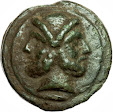top right - Iberia, Ikalesken; Mid 2nd century BC AR denarius. Obv - Male head right; Rev - Horseman, holding shield, helmet and cloak (chlamys); riding left, second horse beside; in ex - Iberian legend IKALESKEN. The cloak and helmet of the rider are similar to the Dioscurii on RR coins. There are three small dots above the rider's helmet.
center - this coin was incorrectly sold as: Ancient Roman Republican Coin - L. Sempronius Pitio - Galley Semis 148 BC. Obv: laureate head of Saturn right, S behind head. Rev: L dot SEMP above prow right, S to right, ROMA below. Craw. 216/3; Syd. 403a; Babelon Sempronia 5; Sear 858. the coin is really:
an official Spanish civic issue from Carteia - Saturn / prow bronze from Spain. Probably about 100 BC (Cited from: https://www.cointalk.com/threads/l-sempronius-pitio-semis-scarce-rr-or-spanish-imitative-issue.327841/)
bottom L & R - SPAIN, Carthago Nova. Roman Occupation. Æ Unit. Struck after 209 BC. Bare-head left (Scipio Africanus?) / Horse standing right; palm tree behind.
This was my original post. You can compare the coin below with a similar RR coin.





















